Medical software development companies offer the development of the vide range of digital solutions to address complex needs of the healthcare sector. These include Electronic Health Records (EHR) systems that digitize patient data, telemedicine platforms enabling remote consultations, AI-powered diagnostic tools that assist clinicians in early disease detection, patient engagement and management applications, medical imaging software, medical billing and revenue cycle management systems, and other.
Top 10 healthcare software development companies

 21 minutes read
21 minutes read
Content
In 2025, the global healthcare software market is valued at hundreds of millions of dollars and is projected to grow at a compound annual growth rate (CAGR) exceeding 10%, with estimates reaching over $90 billion by 2034. This growth is a result of the adoption of electronic health records (EHRs), telehealth, artificial intelligence (AI), big data analytics, and cloud technologies, which are reshaping the way healthcare providers, payers, and patients interact.
Healthcare development companies appear among the leaders of this evolution. They build custom solutions that address specific needs and challenges of the industry, meet strict and complex regulatory demands, and ensure data security and interoperability. This article examines the current state of the HelathTech market, highlights key technologies that drive the industry, and explores the challenges and ways to resolve them. It also offers guidance on selecting the right healthcare software development partner, along with a list of the top companies in the market.
Impact of custom healthcare software development companies on the industry
It’s hardly possible to overestimate the role custom medical software development companies play now in transforming the healthcare industry. Adoption of electronic health records (EHRs), telemedicine platforms, cloud-based management systems, personalized care plans, and many other solutions helps healthcare organizations move away from fragmented legacy systems toward user-centerd solutions that enhance clinical decision-making and patient outcomes.
More healthcare organizations leverage advanced technologies like artificial intelligence (AI), machine learning (ML), and predictive analytics to enable more personalized and efficient care, and improve precision in chronic disease management. Additionally, custom software automates various administrative tasks such as scheduling, billing, routine checks, and claims management, significantly increasing operational efficiency.
Another paramount aspect in healthcare — security and compliance — also benefits from advanced technologies. Custom software development companies embed stringent regulatory requirements, such as HIPAA and GDPR, into their solutions from the ground up, ensuring solid data protection through encryption, access controls, and audit trails. Such an approach helps organizations avoid breaches and penalties.
Finally, HelathTech services providers are focused on delivering scalable, interoperable, adaptable, user-friendly platforms. They consider the ever-changing healthcare market, regulations, and the latest technological trends, and this competition drives the companies and the industry towards more innovative and top-quality solutions.
Technologies behind the success of top HealthTech development companies
AI and ML applications
Artificial intelligence (AI) and machine learning (ML) have become foundational technologies powering the healthcare software industry in 2025. AI systems analyze medical images with incredible accuracy rates, even surpassing human radiologists in some cases. For example, the accuracy of lung nodule detection by some AI-powered systems is 94%, and the sensitivity of breast cancer detection is 90%. These technologies enable faster and more accurate diagnoses, which are critical for early intervention.
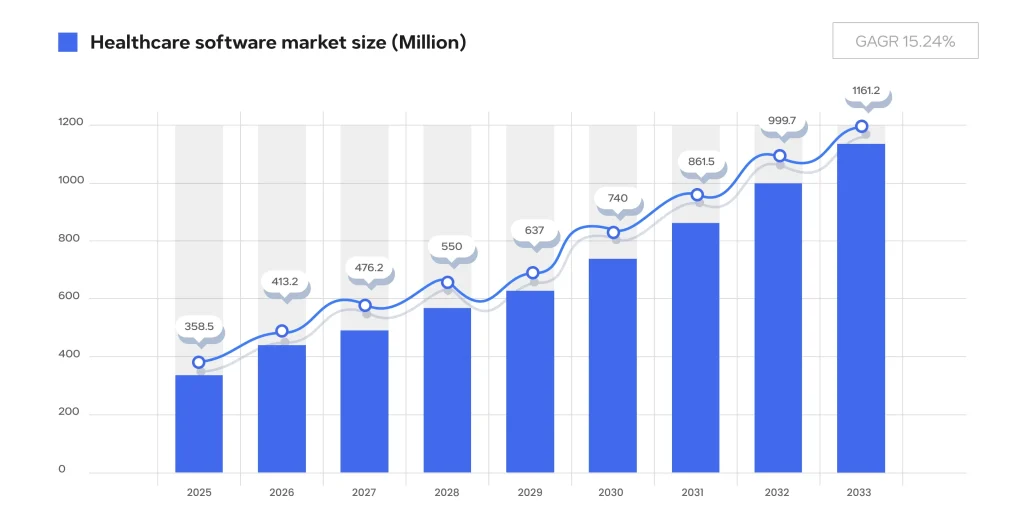
AI also improves personalized treatment plans. It quickly analyzes genetic and treatment history, and real-time health data, and offers top precision in therapies. Furthermore, AI-driven automation reduces administrative burdens, cutting operational costs by hundreds of billions annually only in the U.S. Predictive analytics powered by ML models identify early risks for chronic diseases such as Alzheimer’s and diabetes, enabling preventive care.
While the advantages are phenomenal, the smooth integration of AI into clinical workflows still requires human oversight as well as expertise in handling complex cases. Artificial intelligence development remains a complement rather than a replacement for medical professionals.
Big data for personalized healthcare solutions
The enormous amount of healthcare data generated by electronic health records (EHRs), wearable devices, genomics, and telehealth platforms has created the need for the rapid growth of big data analytics in healthcare software. Consequently, the global big data healthcare market is projected to grow at a CAGR of 22.3%, with forecasts indicating a value of $76.1 billion by 2029.
Healthcare software companies use descriptive, predictive, and prescriptive analytics to build solutions that are more personalized and provide better patient outcomes while improving, at the same time, operational efficiency. Predictive analytics models assess individual disease risks and enable early interventions and personalized treatment plans. At the same time, population health analytics identify at-risk groups and optimize resource allocation. Big data also enhances drug discovery by analyzing genomic sequences and chemical compounds to accelerate candidate identification and reduce trial bottlenecks.
Such a data-driven approach to healthcare software development empowers providers to shift from reactive to proactive healthcare, improving both quality and cost-effectiveness.
Challenges and solutions in healthcare software development
Despite the abovementioned technological advances, healthcare software development faces challenges, specifically in data security, privacy, and system compatibility. Protecting sensitive patient information is non-negotiable; regulations like HIPAA and GDPR impose strict compliance requirements. Healthcare data breaches remain a critical risk, creating a demand for robust encryption, multi-factor authentication, and continuous security audits embedded in software design.
Another major challenge is system compatibility gaps caused by legacy infrastructure and mixed data standards. To deal with data silos and its impact on patient care and analytics, top healthcare software companies adopt modular architectures, standardized protocols, and custom integration layers that enable seamless interoperability between new and legacy systems. Additionally, thorough testing and validation ensure that software meets functional and regulatory requirements.

Key factors to evaluate when choosing a healthcare software development company
Technical expertise
Companies with strong technical expertise can design flexible, secure, and future-proof solutions that adapt to specific and fast-changing healthcare needs and regulatory demands. While evaluating the company, pay attention to its proficiency in emerging technologies such as artificial intelligence (AI), machine learning (ML), big data analytics, and cloud computing.
As a part of the technical evaluation, ask about compliance with regulations such as HIPAA in the U.S., GDPR in Europe, and FDA standards for certain medical applications. Developers must have deep knowledge of healthcare data security, encryption methods, and privacy protocols.
Portfolio and case studies
A company’s portfolio and case studies serve as a proof of their capabilities and expertise. Look for detailed examples of healthcare software projects similar in scope and complexity to yours. Case studies should highlight the problems addressed, technologies used, compliance challenges overcome, and measurable outcomes such as improved patient engagement, reduced operational costs, or enhanced diagnostic accuracy.
For example, a portfolio showcasing development of ML-powered lab diagnostic software, telemedicine platforms, or personalized training systems demonstrates the company’s ability to handle the newest healthcare technologies. Additionally, case studies that emphasize successful compliance with HIPAA and FDA regulations indicate maturity in handling healthcare-specific complexities. A strong portfolio assures you that the company can deliver results aligned with your strategic goals.
Client testimonials and reviews
Client testimonials and independent reviews provide valuable insights into a company’s reliability, professionalism, communication style, and quality of service. Positive feedback about the delivered solution and the cooperation process with the company signals that it’s trustworthy and people-oriented. Look for testimonials that mention the company’s responsiveness, ability to meet deadlines, quality of deliverables, and effectiveness in navigating regulatory requirements.
Platforms like Clutch, GoodFirms, and Gartner Peer Insights offer verified client reviews and ratings that can help you gauge a company’s reputation. Additionally, direct references from past clients allow you to ask specific questions about project management, communication, post-launch support, and problem-solving.
Communication and collaboration
Effective communication and collaboration are essential for the success of healthcare software projects, considering it often involves complex requirements and regulatory nuances. Choose a company that emphasizes transparency and maintains open channels through regular meetings, progress reports, and agile development practices. This way, you ensure that your feedback or last-minute changes are incorporated swiftly and that any issues are addressed as early as possible.
Ask about collaboration tools the company uses (Jira, Trello, Slack, Microsoft Teams). Is there a dedicated project manager who understands healthcare nuances and can bridge technical and business teams? Furthermore, cultural fit and language proficiency are vital for smooth collaboration, especially when working with offshore or nearshore teams.
Pricing and contract terms
Pricing models and contract terms vary widely in healthcare software development, so it’s important to evaluate all of them. Common pricing models include fixed-price, time-and-materials, and dedicated team. Fixed-price contracts offer budget certainty but can’t be very flexible if requirements change, whereas time-and-materials models provide adaptability but require close monitoring to control costs.
Healthcare projects often require ongoing maintenance, updates, and compliance audits, so consider contracts that include post-launch support. Transparent pricing with no hidden fees is critical to avoid budget overruns. Additionally, review contract clauses related to intellectual property rights, confidentiality, liability, and termination conditions.
Location and time zone
The location and time zone of your healthcare software development partner can significantly impact communication efficiency and project timelines. Working with companies in similar or overlapping time zones improves real-time collaboration and decision-making, and quicker issue resolution.
Weigh in the pros and cons of companies in your time zone, and possible cost benefits and technical expertise from ones that operate in different locations to find the one that overlaps all your demands. Consider language proficiency, cultural compatibility, and willingness to accommodate your and the company’s working hours when selecting a partner. Offshore and nearshore companies usually offer flexibility in terms of working hours.
Comapanies development process
Understanding a healthcare software development company’s process is crucial. It usually starts with a discovery and requirements analysis phase, where the company defines detailed functional, technical, and compliance needs. This phase includes risk assessments related to data privacy and security.
Next, the company moves to design and prototyping, creating system architecture and user interfaces that prioritize usability and compliance. Following this, the development begins, allowing iterative builds with frequent client feedback to adapt to evolving healthcare regulations and user needs. Integration with existing healthcare systems such as EHRs, billing, and telehealth platforms is a critical step, often requiring custom APIs and middleware.
Before deployment, the software undergoes rigorous testing and validation to ensure security, interoperability, and regulatory compliance. Finally, the company provides deployment support, user training, and ongoing maintenance, including updates for regulatory changes and security patches.


Enhance patient care and streamline operations
Build your custom healthcare software solution today!
Selecting a HealthTech partner: A step-by-step guide
Identify your company’s needs
The first and most critical step in selecting a HealthTech partner is to clearly define your company’s goals, challenges, and project requirements. Outline what you aim to achieve with the technology — improved patient care, optimized clinical workflows, enhanced data security, better telehealth services, better asset management, etc. Your assessment should specify desired functionalities, compliance requirements, scalability expectations, and needs related to integration with existing systems. Having all this helps your potential technical partners understand your vision and deliver accordingly.
Discover and make a list of potential companies
When your needs are defined, begin researching potential HelathTech partners through different channels. Use industry networks, healthcare IT conferences, and professional associations to find companies with proven healthcare expertise. Online platforms such as Clutch, GoodFirms, and Business of Apps help you with their ratings, reviews, and case studies to assess vendor credibility. Referrals from trusted colleagues and industry insiders also offer reliable leads. Create a shortlist of companies that demonstrate a strong track record in healthcare software development, particularly those experienced with technologies relevant to your project like AI, EHR integration, or telemedicine.
Assess technical expertise
Evaluating your potential partner’s technical expertise is essential. Review their portfolio and case studies for evidence of successfully implemented projects similar in scale and complexity to yours. Additionally, assess their software development methodologies, security protocols, and ability to integrate with legacy systems. Look for companies proficient in healthcare IT standards such as HL7, FHIR, and DICOM, as well as regulatory compliance frameworks like HIPAA and GDPR. Their experience with emerging technologies — AI, machine learning, big data analytics, cloud computing, and mobile health — is a strong indicator of their ability to future-proof your product.
Estimate communication and collaboration skills
Effective communication and collaboration are vital for the success of healthcare software projects. Evaluate how potential partners manage client engagement, including their responsiveness, transparency, and willingness to provide regular updates. Companies that adopt agile development practices and use collaboration tools typically offer smoother workflows and quicker issue resolution. Cultural compatibility and language proficiency also matter and influence communication quality. Schedule initial discovery calls or workshops to assess interpersonal dynamics and ensure a good fit.
Evaluate prices and contracts
Understand the vendor’s pricing model and choose the one that aligns with your project’s scope and needs. Carefully review contract clauses, focusing on intellectual property rights, confidentiality, liability, and termination conditions. Ensure that post-launch support, maintenance, and compliance updates are included or available as add-ons. Transparent pricing with no hidden fees and flexible contract terms helps you avoid budget overruns and legal complications, which are especially critical in the healthcare sector.
Conduct a reference check
Reference checks help you evaluate a potential partner’s performance and reliability. Request contacts for previous clients in the industry and inquire about their experience in project delivery, technical competence, communication, and post-deployment support. Ask specific questions about the vendor’s ability to meet deadlines, deal with regulatory compliance, or resolve specific issues. This way, you can also ensure a cultural and visionary match with your technical partner.
Consider additional factors
Additional factors that can potentially influence your partnership include the company’s location and time zone compatibility, the company’s financial stability, and organizational culture, especially if you’re considering a long-term partnership. Evaluate their commitment to inclusivity and sustainable development practices. Taking a view from various perspectives will help you build a resilient and effective partnership that supports not just your organization’s goals but also its vision and values.
The top 10 healthcare software development companies
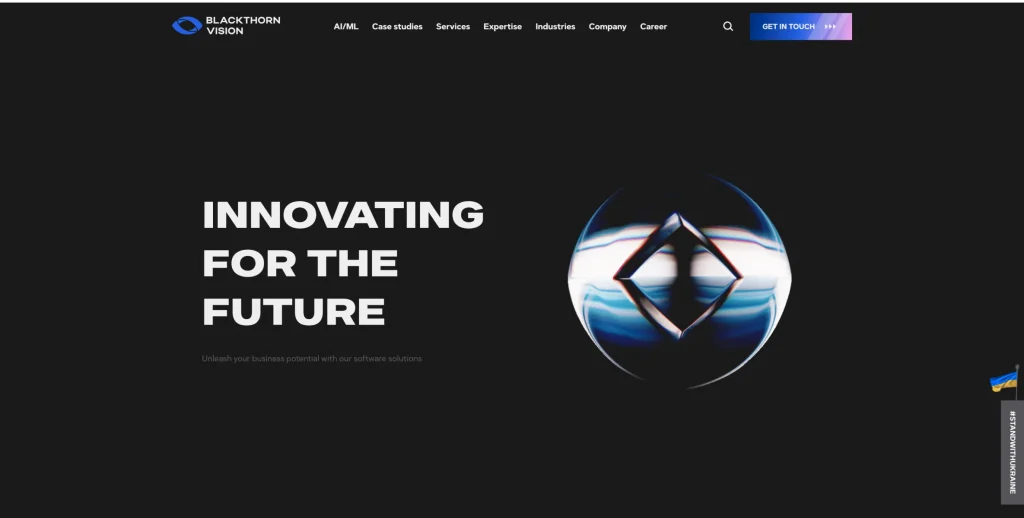
Blackthorn Vision
Blackthorn Vision stands out as an innovator specializing in AI-powered healthcare software solutions, particularly in diagnostic imaging and patient management. The company actively adopts the latest artificial intelligence and machine learning technologies and develop platforms that enhance clinical decision-making and improve patient outcomes. The company’s expertise spans telehealth, cloud computing, and healthcare interoperability standards, and they ensure smooth integration of the delivered systems with existing infrastructures.
Blackthorn Vision’s portfolio includes AI-driven diagnostic tools and remote monitoring systems. Clients appreciate their deep healthcare domain knowledge, agile development processes, and strong post-deployment support. The company is focused on building a strategic technical partnership and long-term cooperation with healthcare providers and medical companies worldwide.
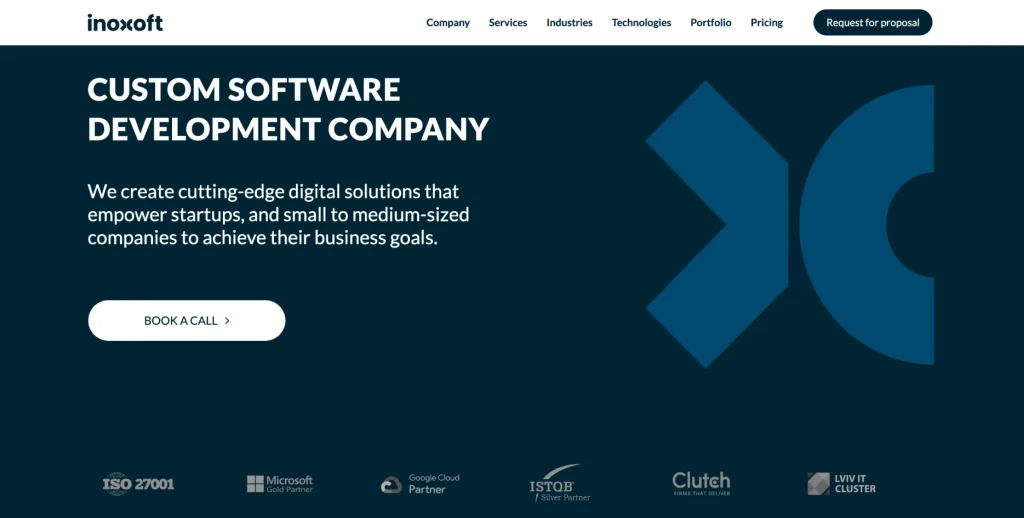
Inoxoft
Inoxoft is a global software development firm with a strong foothold in healthcare software development. It is known for delivering custom solutions along with cloud migration, big data analytics, telemedicine platforms, and medical device integration. Inoxsoft’s technical proficiency covers Java, .NET, and big data frameworks like Hadoop and Spark, combined with expertise in healthcare interoperability and compliance standards such as HIPAA and GDPR.
The company’s healthcare portfolio features hospital management systems, patient portals, and predictive analytics tools that optimize clinical workflows and patient engagement. Inoxsoft serves hospitals, insurance companies, and telemedicine providers.
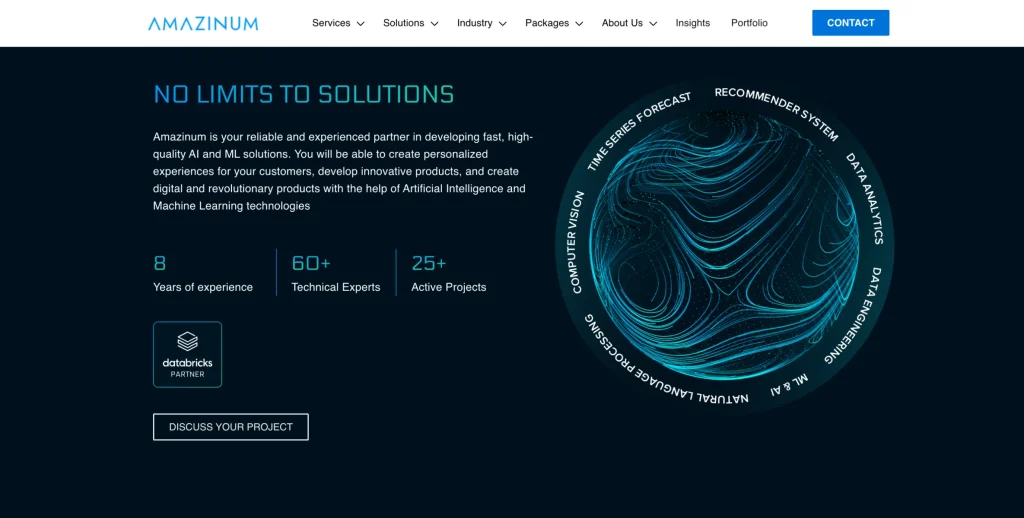
Amazinum
Amazinum focuses on scalable healthcare platforms that use AI and data analytics to provide personalized medicine. Their services include AI-driven diagnostics, cloud-based electronic health records (EHRs), and patient engagement systems. Amazinum’s team comprises data scientists, software architects, and healthcare IT specialists proficient in Python, R, AWS, and HL7/FHIR standards.
Amazinum’s portfolio highlights AI-powered diagnostic applications and chronic disease management platforms. Clients value Amazinum’s innovative approach, ability to customize solutions, and user-friendly interfaces. The company primarily serves healthcare providers, pharmaceutical companies, and telemedicine startups.
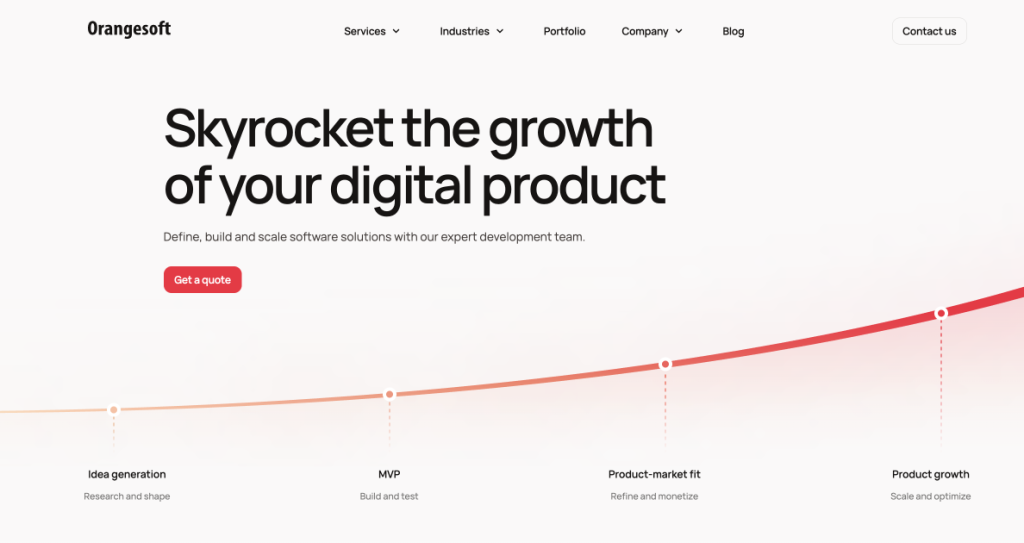
Orangesoft
Orangesoft builds custom medical-grade and consumer-focused healthcare software solutions, compliant with HIPAA, GDPR, FDA, MDR, and other healthcare regulations. The company has over 14 years of experience in the field, plus complementary AI, IoM, gen AI, and AR/VR tech chops. Orangesoft has a cross-functional team of 100+ mid- and senior tech specialists who specialize in Swift, Kotlin, React Native, Node.js, Python, and other staple healthcare technologies. Backed by an ISO-aligned development process, the company delivers adoption-ready healthcare solutions built with security, compliance, and accessibility in mind.
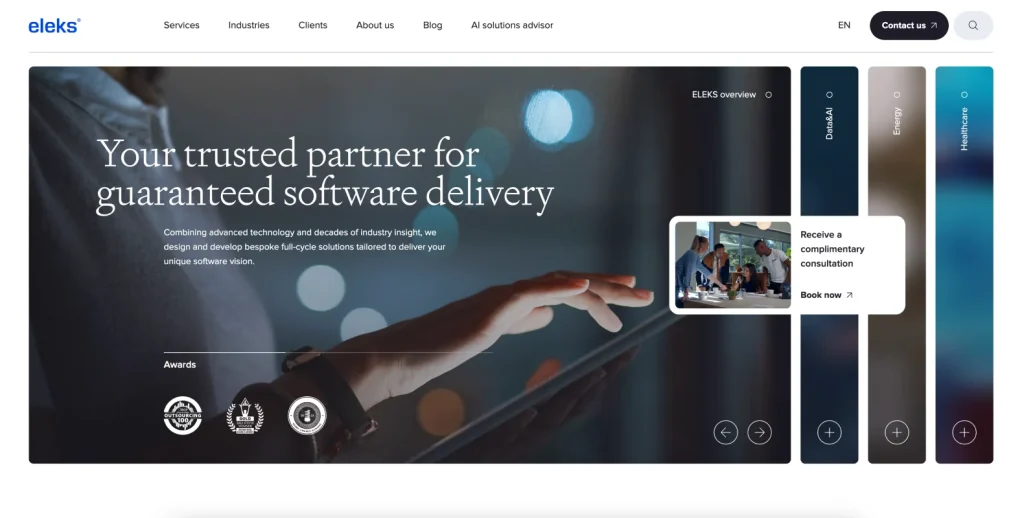
ELEKS
ELEKS is a global technology partner known for end-to-end healthcare software development, integrating AI, machine learning, cloud computing, and IoT technologies. Their services cover custom software development, data analytics, and cybersecurity. ELEKS is focused on addressing the needs of healthcare providers, pharmaceutical companies, and medical device manufacturers, and boasts a large team of over 2000 professionals specializing in Python, Java, AWS, Azure, and healthcare interoperability standards. Their portfolio includes AI-powered diagnostic platforms, telehealth systems, and patient management software.
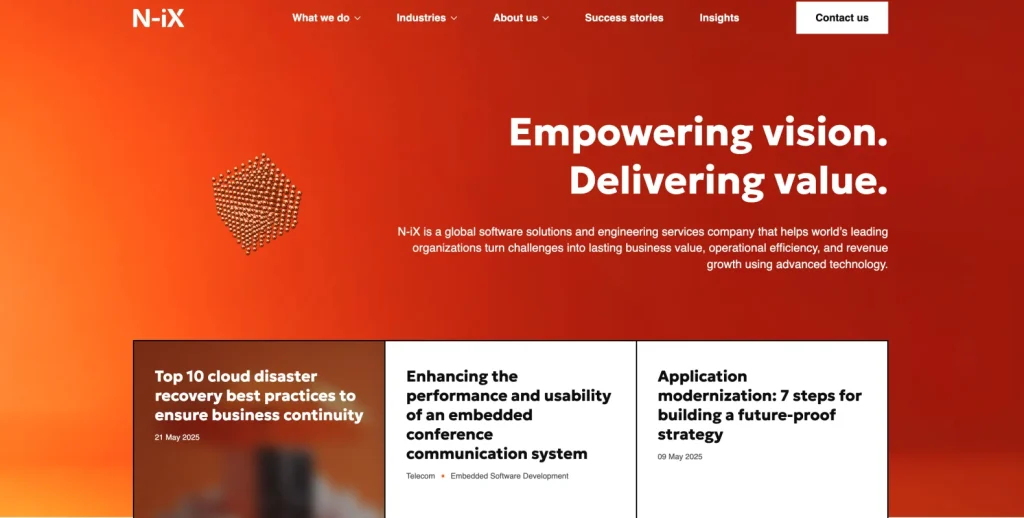
N-iX
N-iX offers healthcare software development services focusing on interoperability, security, and cloud-based solutions. Their expertise includes .NET, Java, AI, and big data analytics. N-iX’s development teams are experienced in integrating EHR systems, developing AI diagnostic tools, and building telemedicine applications. Clients highlight their technical depth, security focus, and flexible engagement models. With approximately 1500 employees, N-iX serves hospitals, insurance providers, and telehealth companies across countries and continents.
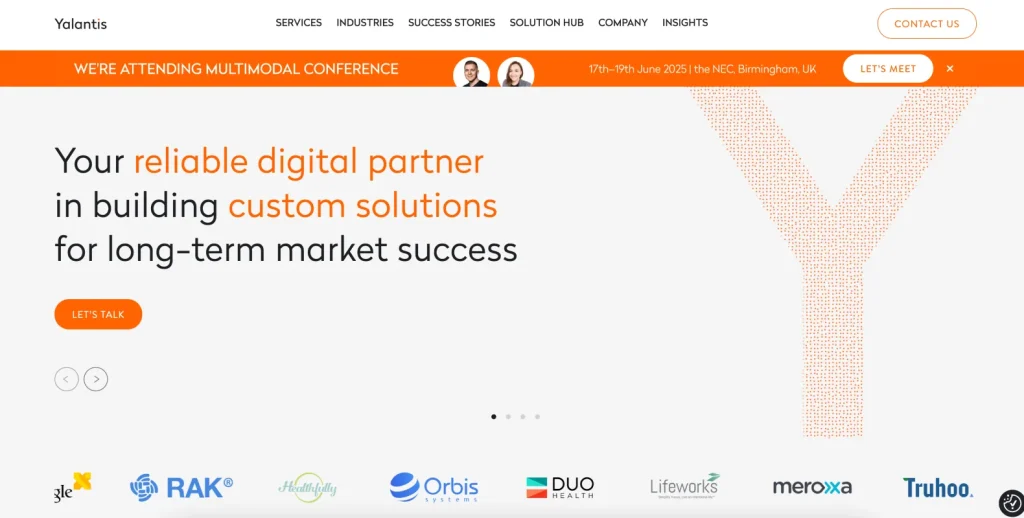
Yalantis
Yalantis is among healthcare mobile app development companies, specializing in mobile health solutions and telemedicine platforms. Their services include mobile app development for iOS and Android, cloud computing, AI integration, and IoMT device connectivity. Yalantis’s team consists of mobile developers, UX/UI designers, and healthcare consultants using technologies like Swift, Kotlin, React Native, and AWS. The company’s portfolio features telemedicine apps, remote patient monitoring systems, and wellness platforms.
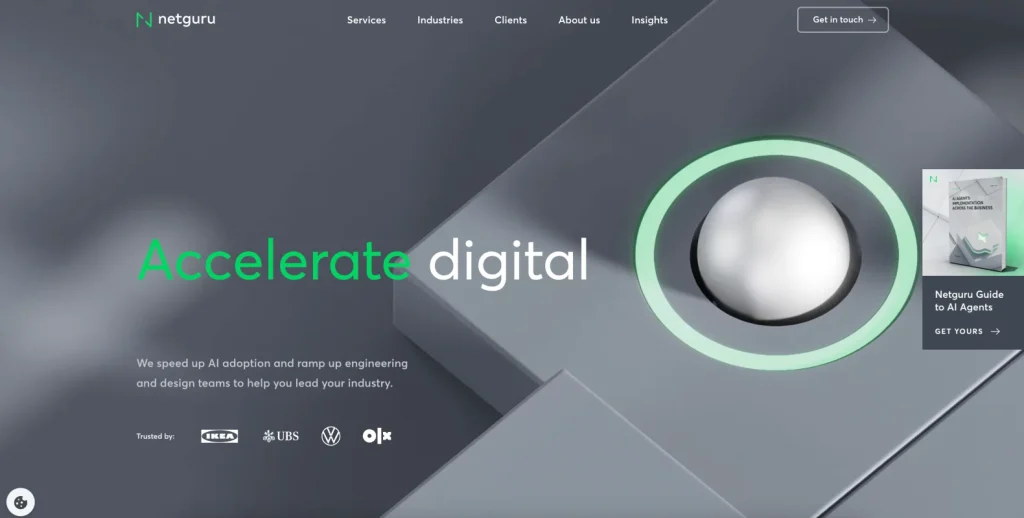
Netguru
Netguru is a globally operating software development company with a strong presence in the healthcare sector. The company specializes in custom healthcare software development, focusing on mobile health applications, telemedicine platforms, electronic health records (EHRs), and healthcare data integration systems. Netguru’s services span the full software development lifecycle, including consulting, UI/UX design, backend and frontend development, cloud infrastructure, and ongoing support.
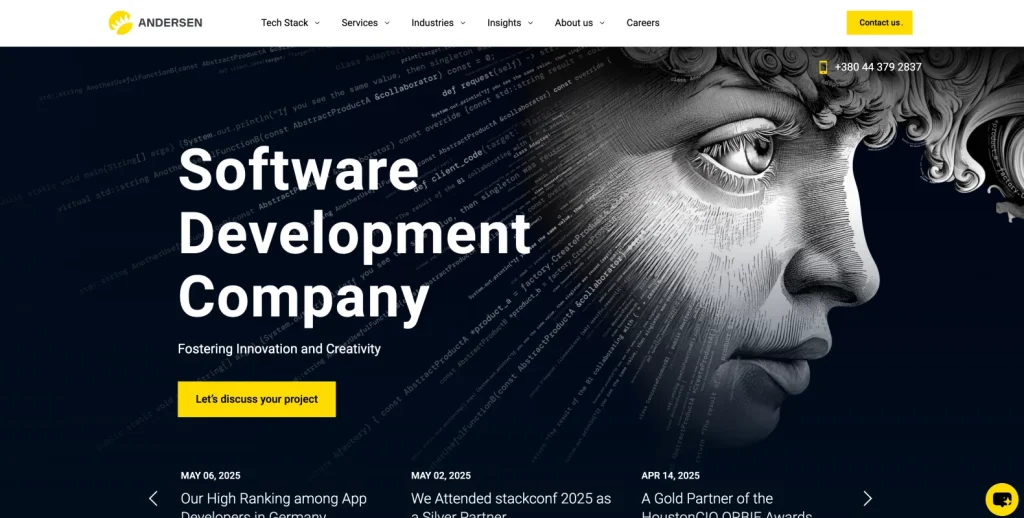
Andersen
Andersen is a healthcare software development company with a portfolio comprising custom solutions and AI integration. Their services cover custom software development, AI and machine learning, cloud computing, and compliance consulting. Andersen’s technical stack includes .NET, Java, Python, AWS, and Azure. Among their healthcare case-studies are AI diagnostics, patient management systems, and telehealth platforms. With employees spread across Ukraine, the U.S., and Europe, Andersen serves healthcare providers, pharmaceutical companies, and insurers looking for innovative software solutions and cultural match.
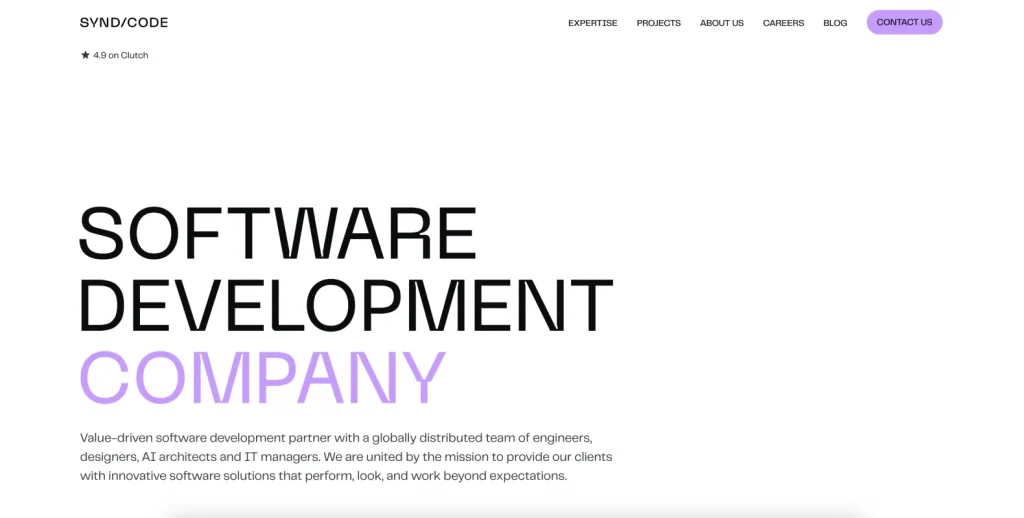
Syndicode
Syndicode is a healthcare software development company emphasizing data privacy, security, and custom integrations. Their services include custom healthcare software, secure patient portals, EHR integration, and telehealth solutions. Syndicode’s technical expertise covers .NET, JavaScript, Azure, AWS, and healthcare interoperability standards, with a strong focus on HIPAA compliance and cybersecurity.
Trendy healthcare software development companies in USA

Blackthorn Vision
Blackthorn Vision is a software development company renowned for its AI-powered diagnostic tools and patient management platforms. They focus on delivering innovative and scalable solutions aimed to improve clinical processes and streamline healthcare management and workflows.
With their expertise in the HealthTech industry, Blackthorn Vision addresses critical challenges in the American and European healthcare sectors. They help reduce hospital readmission rates, optimise telehealth workflows amid regulatory complexity, simplify diagnosting, and ensuring secure patient data exchange across fragmented healthcare systems.
Key services: Custom healthcare software development, AI-driven diagnostics, telehealth platforms, patient engagement tools, healthcare data analytics, and software modernization.
Industry specific skills: Expertise in AI and ML, cloud computing (AWS, Azure), healthcare interoperability standards (FHIR, HL7), regulatory compliance (HIPAA, GDPR).
Talents: A diverse team of data scientists, healthcare domain experts, software engineers, QA specialists, AI/ML experts, and UX/UI designers.
Tech stack: .NET development, Node.js, JavaScript development, Blazor, Xamarin, .NET MAUI, Microsoft Azure, Amazon Web Services (AWS)
Portfolio: AI-based imaging analysis tools, remote patient monitoring systems, integrated EHR platforms, personalized training applications, lab diagnostic systems.
Reviews: With an outstanding 4.9/5 rating on Clutch and multiple positive client testimonials, Blackthorn Vision is praised for professionalism, responsiveness, and technical excellence. Clients value Blackthorn Vision’s dedication beyond mere execution, their proactive problem-solving, and the seamless integration of AI technologies that enhance healthcare delivery. They also highlight the company’s collaborative approach and ability to deliver on time.
For example, Berkeley Lights’ VP of Software commended their professionalism and attention to detail, while Sensia’s Digital Architect noted the company’s genuine interest in understanding end-user needs. On G2, users appreciate their easy-to-use messaging solutions and timely support.
HQSoftware
HQSoftware is a software development company with over two decades of experience delivering healthcare IT solutions that address the unique challenges of the American healthcare system. Known for its custom software development and IT consulting, HQSoftware supports healthcare providers and payers in improving operational efficiency and patient engagement through technology.
HQSoftware helps healthcare organizations overcome interoperability barriers, automate claims processing, and enhance patient engagement through mobile-first solutions.
Key services: Custom software development, mobile app development, dedicated development teams, software consulting, web application development, and cloud migration.
Industry specific skills: Proficiency in Angular, JavaScript, Java, PHP, MySQL, Node.js, Flutter, and Symfony, combined with healthcare interoperability and compliance knowledge.
Talents: Experienced developers, project managers, healthcare IT consultants, and quality assurance specialists.
Tech stack: Angular, JavaScript, Java, PHP, MySQL, Node.js, Flutter, Symfony.
Portfolio: Hospital management systems, patient portals, telemedicine applications, and healthcare analytics platforms.
Reviews: Clients appreciate HQSoftware’s ability to deliver reliable, scalable solutions tailored to complex healthcare workflows. Their responsiveness and adaptability to regulatory changes, such as HIPAA updates, are frequently noted.
Ravn
Ravn is a HealthTech company specializing in behavioral health and ABA (Applied Behavior Analysis) provider solutions, addressing a quickly growing segment in the U.S. healthcare market. Their all-in-one ABA platform simplifies clinical data collection, scheduling, billing, and reporting, releasing providers from the administrative burdens and enabling them to focus on patient care.
Ravn is focused in addressing challenges such as complex insurance reimbursement processes, clinician burnout from paperwork, and the need for HIPAA-compliant, mobile-accessible platforms in behavioral health.
Key services: ABA practice management software, client data management, scheduling, billing, insurance reimbursement optimization, and reporting tools.
Industry specific skills: User-centric design, secure cloud infrastructure, HIPAA-compliant data management, and mobile-first development.
Talents: Software developers, UX/UI designers, healthcare compliance experts, and clinical workflow consultants.
Tech stack: React, Node.js, AWS, secure encryption protocols.
Portfolio: A comprehensive ABA platform used by new and growing behavioral health providers, featuring customizable graphing software for behavior analysis and VB-MAPP assessment tracking.
Reviews: Users commend Ravn for its intuitive interface, fast onboarding (BCBAs learn in under an hour), and significant improvements in billing accuracy and insurance collections (some report over 30% increase).
Closeloop Technologies
Closeloop Technologies is an Austin-based healthcare software development company recognized for its AI-driven data science platform tailored to U.S. healthcare and life sciences organizations. The company won the Centers for Medicare & Medicaid Services (CMS) AI Health Outcomes Challenge, underscoring its position among leaders in healthcare AI innovation.
Key services: AI and machine learning healthcare platforms, data onboarding and normalization, automated feature engineering, model training and validation, MLOps, and healthcare analytics.
Industry specific skills: AI/ML, big data analytics, cloud computing, healthcare data standards, and compliance with HIPAA and CMS regulations.
Talents: Data scientists, AI researchers, software engineers, healthcare analytics experts.
Tech stack: Python, TensorFlow, Kubernetes, AWS, HL7, FHIR.
Portfolio: AI-powered predictive analytics platforms that improve patient outcomes and reduce healthcare costs by identifying high-risk populations and optimizing care pathways.
Reviews: Industry recognition for innovation and effectiveness in reducing healthcare gaps, with clients praising the platform’s ease of use and comprehensive healthcare-specific AI features.
Mayura Consultancy Services
Mayura Consultancy Services (MCS) is a technology partner, aimimg to streamline operations and ensure regulatory compliance with its custom software solutions. The company’s broad portfolio spans numerous industries, including healthcare. MCS helps healthcare providers navigate complex compliance landscapes, optimize patient engagement through mobile apps, and improve care delivery with AI.
Key services: Custom software development, web and mobile app development, AI and data science services, healthcare IT consulting.
Talents: Software developers, healthcare consultants, data scientists, project managers.
Tech stack: Angular, React, Node.js, Python, PHP, Swift, Java, Kotlin, Flutter.
Portfolio: Patient portals, telehealth applications, healthcare analytics dashboards, and compliance management systems.
Reviews: Clients commend MCS for delivering high-quality, scalable solutions on time and within budget, with particular praise for their responsiveness and understanding of healthcare regulatory nuances.
FAQ
What types of healthcare software solutions do these companies typically develop?
What are the most critical factors to consider when choosing a healthcare software development company?
Choosing the right healthcare software development partner requires evaluating several key factors:
- Industry expertise
- Regulatory compliance
- Technical expertise
- Portfolio and references
- Security measures
- Communication and collaboration
- Scalability and flexibility
- Pricing and contract terms
How long does healthcare software development usually take, and what impacts the timeline?
Healthcare software development timelines vary widely depending on project complexity, scope, and regulatory requirements. Simple applications like patient portals or mobile health apps may take 3 to 6 months, while comprehensive EHR systems or AI-powered diagnostic platforms can require 12 to 24 months or more.
Factors influencing the timeline include regulatory compliance, integration complexity, customization level, security requirements, stakeholder involvement, and development methodology.
What is the estimated cost of developing healthcare software, and what factors affect it?
The cost of healthcare software development varies significantly based on project size, complexity, technology stack, and compliance demands. Basic healthcare apps may start around $50,000 to $100,000, while full-featured EHR systems, AI diagnostics, or telehealth platforms can exceed $500,000 to several million dollars.
Key cost drivers include scope and features, compliance and security, integration needs, technology stack, and team location and size.
What regulatory compliances are most crucial for healthcare software, and why are they important?
Regulatory compliance is critical in healthcare software to protect patient privacy, ensure data security, and maintain trust. The most crucial regulations include: HIPAA (Health Insurance Portability and Accountability Act), HITECH Act, GDPR (General Data Protection Regulation), FDA Regulations, and SOC 2 and ISO 27001 Certifications.






























































